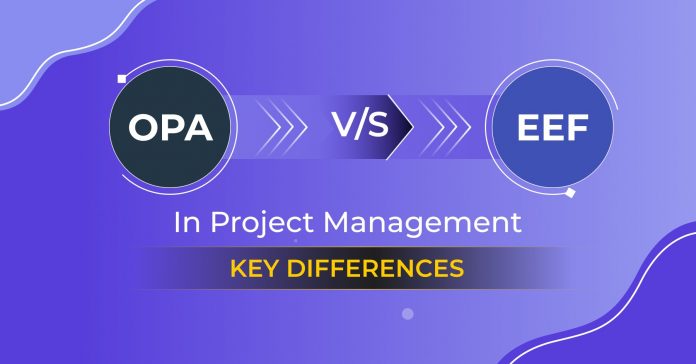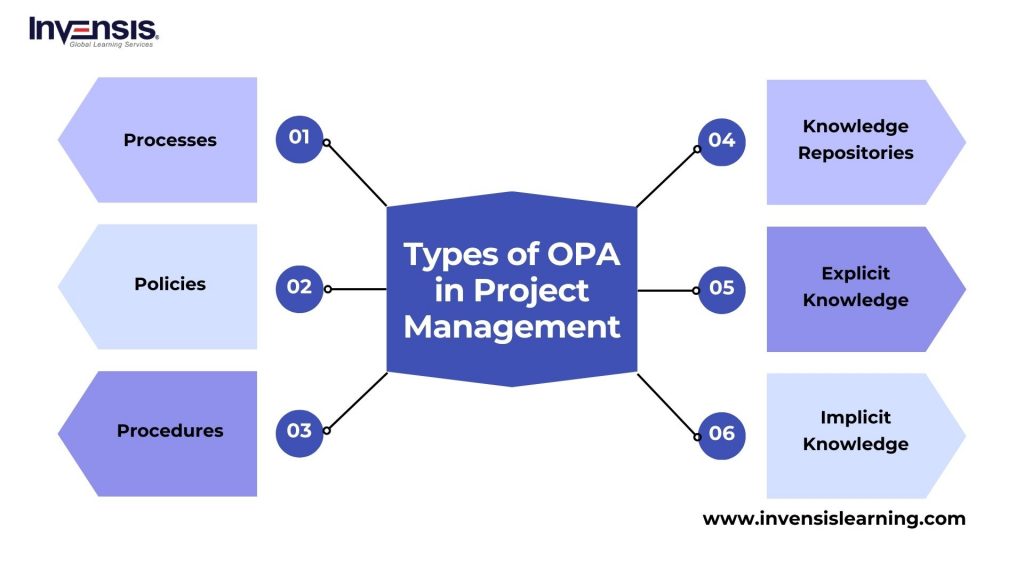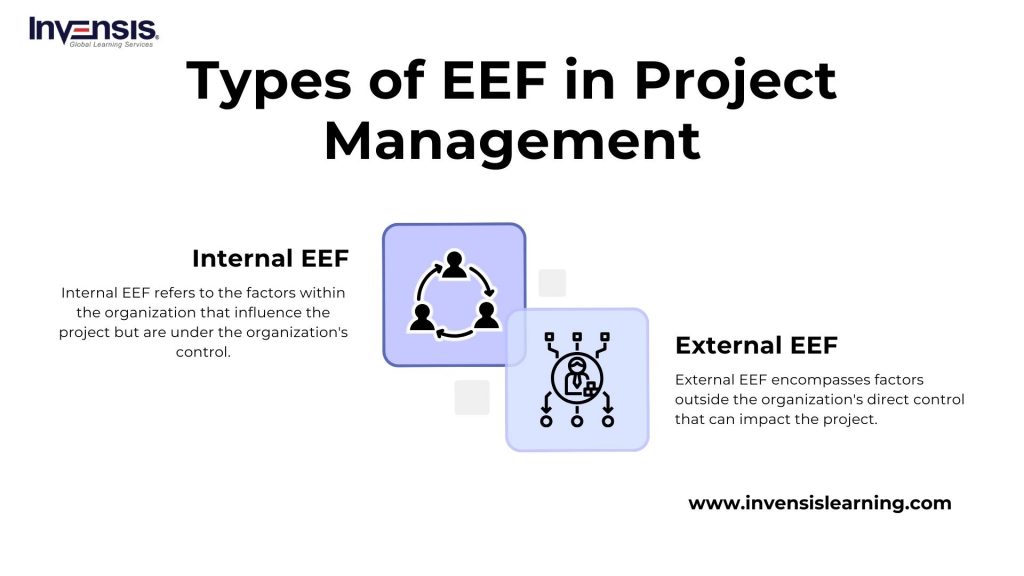
Embarking on the project management journey requires mastery of two critical concepts – Enterprise Environmental Factors (EEF) and Organizational Process Assets (OPA). OPA is the internal factor of your organization—the accumulated wisdom, processes, and tools that propel your projects forward.
On the other hand, EEF represents the external forces shaping your project environment—the regulatory winds, industry currents, and market tides that can propel you forward or challenge your course.
This blog post on OPA vs EEF will enable you to dive deep into the significance, and how they differ. We will also learn about the types of OPA and EEF and provide some examples. Prepare to embark on a journey of professional growth, honing your ability to anticipate, adapt, and ultimately triumph in the dynamic arena of project management.
Table of Contents:
- What is Organizational Process Assets (OPA)?
- Types of OPA in Project Management
- Examples of OPA in Project Management
- What are Enterprise Environmental Factors (EEF)?
- Types of EEF in Project Management
- Examples of EEF in Project Management
- Similarities Between OPA and EEF
- OPA vs EEF: Key Differences
- Conclusion
Without ado let’s start with the fundamentals and clear up any confusion about OPA vs EEF:
What are Organizational Process Assets (OPA)?
Organizational Process Assets (OPA) refer to the accumulated knowledge, processes, and tools an organization has developed and accumulated over time. These assets serve as a valuable internal resource for project management.
OPA encompasses a wide range of elements, including documented processes, historical project data, templates, policies, and procedures specific to the organization. These assets are essential for ensuring consistency and efficiency in project execution.
Organizational process assets (OPA) are defined in the Project Management Body of Knowledge (PMBOK® Guide) as “the plans, processes, policies, procedures, and knowledge bases specific to and used by the performing organization.”
OPA represents the organizational wisdom and institutional memory that project managers and teams can leverage to enhance decision-making, streamline processes, and improve overall project performance. It acts as a repository of best practices and lessons learned, contributing to the organization’s continuous improvement of project management practices.
Types of OPA in Project Management

1. Processes, Policies, and Procedures
- Processes: These are systematic sequences of actions or steps that guide the execution of tasks within a project. Defined processes provide a structured approach to project management, ensuring that activities are carried out consistently and efficiently. Examples include project initiation, risk management, and change control processes.
- Policies: In the context of OPA, organizational policies are guidelines or rules set by an organization to govern project management practices. These policies provide a framework for decision-making and behavior within the project environment. For example, an organization may have policies related to project approval processes, resource allocation, or quality standards
- Procedures: Procedures are detailed step-by-step instructions or guidelines for performing specific tasks within a project. They complement processes by offering a more granular level of guidance. Project management procedures may include instructions on creating project documentation, conducting project meetings, or handling project changes
2. Organizational Knowledge Bases:
- Knowledge Repositories: Organizational knowledge bases encompass repositories of explicit and implicit knowledge accumulated over time. These repositories may include databases, intranet portals, or shared platforms where project-related information, best practices, lessons learned, and relevant documents. Access to this knowledge allows project teams to benefit from the organization’s collective wisdom
- Explicit Knowledge: This refers to knowledge that is codified and easily transferable, such as documented processes, templates, and project reports stored in knowledge bases
- Implicit Knowledge: Implicit knowledge is individuals’ unspoken, experiential knowledge within the organization. While not explicitly documented, tacit knowledge is often shared through interactions and collaboration, contributing to the overall knowledge base
Examples of OPA in Project Management
Examples of Organizational Process Assets (OPA) in project management encompass a variety of resources and tools that organizations utilize to enhance their project management practices. Here are some specific examples:
- Lessons Learned: Captures insights from past projects, highlighting successful strategies and areas for improvement. Guides decision-making and continuous improvement
- Historical Records: Includes past project documentation for benchmarking, analysis, and informed decision-making on current and future projects
- Policies: Establishes guidelines for project initiation, execution, and control, ensuring alignment with organizational objectives and compliance
- Procedures: Offers step-by-step instructions for specific project tasks, ensuring a structured and consistent approach to project activities
- Project Templates: Standardized documents or forms (e.g., project charters, plans) provide a consistent structure for key project artifacts, promoting efficiency
- Knowledge Bases: Repositories of explicit and implicit knowledge, fostering continuous learning through information, best practices, and lessons learned
What are Enterprise Environmental Factors (EEF)?
Enterprise Environmental Factors (EEF) refer to external influences on a project that project managers cannot control. These factors arise from the organizational context and broader external landscape, including legal and regulatory requirements, economic conditions, organizational culture, stakeholder expectations, and technological considerations.
Understanding EEF is essential for project managers to navigate challenges and adapt their approaches to the dynamic external environment, enhancing the project’s chances of success.
The Project Management Body of Knowledge (PMBOK® Guide) defines EEF as “conditions, not under the immediate control of the team, that influence, constrain, or direct the project, program, or portfolio.”
Key components of EEF encompass the legal and regulatory framework, economic conditions, organizational culture, stakeholder influences, political and societal factors, technological landscape, risk tolerance, and physical environmental considerations.
Project managers must continually assess and respond to these factors throughout the project lifecycle to optimize project outcomes and ensure alignment with organizational objectives and external constraints.
Types of EEF in Project Management
Enterprise environmental factors (EEF) in project management can be classified into two main categories: Internal EEF and external EEF, which can impact project execution.
Understanding these types of EEF is crucial for project managers to anticipate challenges, make informed decisions, and tailor their project management approaches to their specific external conditions and constraints.
1. Internal EEF
Internal EEF refers to the factors within the organization that influence the project but are under the organization’s control. These factors are typically related to the organization’s policies, culture, resources, and historical performance. Internal EEF can include the organization’s structure, processes, available resources, and top management’s level of support and commitment.
For example, the organizational culture that promotes innovation or a robust project management methodology established within the organization would be considered internal EEF.
2. External EEF
External EEF encompasses factors outside the organization’s direct control that can impact the project. These factors are often beyond the influence of the project team and are related to the broader external environment.
Examples of external EEF include legal and regulatory requirements, economic conditions, market trends, political stability, and technological advancements. External EEF requires project managers to adapt their strategies to account for these external forces that may affect the project’s success.
Examples of EEF in Project Management
Here are some examples of EEF in project management:
- Rules and Regulations: Governing policies, whether internal or external, influence project management processes, impacting areas such as procurement and compliance
- Organizational Culture: The collective values within an organization shape project approaches, risk tolerance, and overall management styles
- Political Environment: Internal politics and external factors, like changes in government policies, can significantly affect project management dynamics
- Industry Standards: Adherence to specific industry standards ensures project quality and alignment with sector norms
- Work Authorization System: Formal processes for project initiation, including approvals and resource allocation, are essential components of the work authorization system
- Human Resource Skills: The skills and adaptability of human resources play a crucial role in project success, encompassing expertise and collaborative abilities
Similarities Between OPA and EEF
OPA and EEF in project management share common ground in their significant influence on project success and their integral roles in project planning and execution. OPA, representing internal assets, contributes to project achievements by offering a repository of knowledge and best practices cultivated within the organization.
Likewise, EEF, comprising external conditions, shapes the project environment and requires careful consideration during project planning to anticipate challenges and ensure alignment with the external landscape.
Both OPA and EEF are dynamic, with internal assets evolving through continuous improvement efforts and external factors changing over time. Project managers incorporate these elements into various project processes, leveraging OPA for optimized project management practices and considering EEF as a crucial input to decision-making, risk management, and adaptation strategies.
Recognizing the similarities between OPA and EEF enables project managers to seamlessly integrate internal strengths and external considerations, fostering adaptability and enhancing the project’s overall success.
OPA vs EEF: Key Differences
Organizational Process Assets (OPA) and Enterprise Environmental Factors (EEF) are crucial concepts in project management. Both OPA and EEF play crucial roles in shaping the project environment, but they differ in their nature, origin, and influence. Here’s a breakdown of the key distinctions:
1. Nature
- OPA: Organizational Process Assets are internal to the organization. They encompass the accumulated knowledge, processes, templates, and historical information that the organization has developed over time
- EEF: Enterprise Environmental Factors, in contrast, are external conditions and influences that are not under the direct control of the project team. They stem from the broader organizational and external context within the project
2. Origin
- OPA: Originating from within the organization, OPA includes documentation, procedures, and knowledge repositories specific to the organization’s practices and experiences
- EEF: External to the organization, EEF arises from factors such as legal requirements, market conditions, societal influences, and regulatory frameworks
3. Control
- OPA: Project managers and the project team have control over OPA. They can leverage and adapt internal assets to enhance project processes and decision-making
- EEF: The project team has limited control over EEF. These external factors are largely uncontrollable, requiring the team to adapt their strategies to external conditions
Examples
- OPA: Examples of OPA include project management methodologies, templates, lessons learned from past projects, and organizational policies and procedures
- EEF: Examples of EEF include legal regulations, economic conditions, market trends, technological advancements, and political stability
4. Purpose
- OPA: OPA serves as a repository of internal knowledge and assets, providing a foundation for consistent project management practices and continuous improvement
- EEF: EEF influences the project environment and requires project managers to consider external conditions that may impact the project’s success
5. Adaptability
- OPA: This can be adapted and tailored by the project team to suit the project’s specific needs, fostering flexibility and efficiency
- EEF: Requires the project team to adapt their strategies based on external conditions, as these factors are often beyond the project team’s control
Understanding the distinctions between OPA and EEF is vital for project managers to effectively leverage internal assets and navigate external influences, ensuring the successful execution of projects within the dynamic project environment.
Here’s a tabular representation of the key differences between Organizational Process Assets (OPA) and Enterprise Environmental Factors (EEF) in project management:
| Aspect | Organizational Process Assets (OPA) | Enterprise Environmental Factors (EEF) |
| Nature and Origin | Internal to the organization; developed over time | External to the organization; beyond project team control |
| Control | Project team has control; can be leveraged | Limited control; adaptation to external conditions |
| Examples | Methodologies, templates, lessons learned, policies | Legal regulations, economic conditions, market trends |
| Purpose | Foundation for consistent practices, continuous improvement | Influences the project environment, requires consideration |
| Adaptability | Can be adapted and tailored by the project team | Requires adaptation based on external conditions |
Conclusion
Differentiating between OPA and EEF is crucial for effective project management. OPA acts as an organizational knowledge repository, originating internally and within the project team’s control. Conversely, external and uncontrollable EEF demands adaptability to navigate the changing project environment.
Both OPA and EEF influence project success, with OPA providing internal strengths and EEF presenting external challenges. Successful project management involves balancing and leveraging these factors.
By understanding and managing the interplay between OPA and EEF, project managers can make informed decisions and enhance their projects’ overall success in the dynamic field of project management.
Transform your career with Invensis Learning’s Project Management Certification Courses. Gain a competitive edge through expert-led training, practical insights, and globally recognized certifications. Enroll today to advance your project management skills and propel your professional journey.















